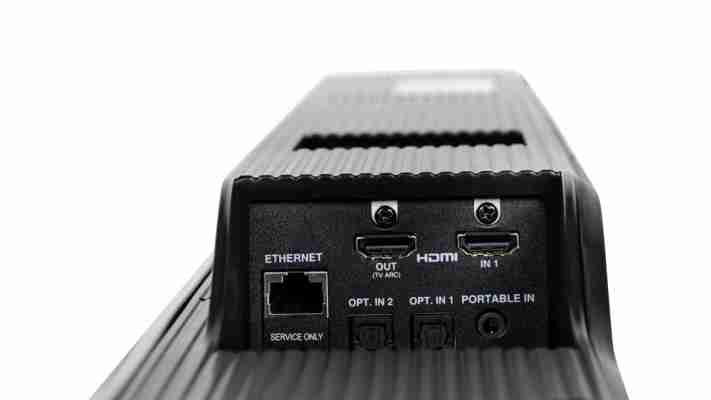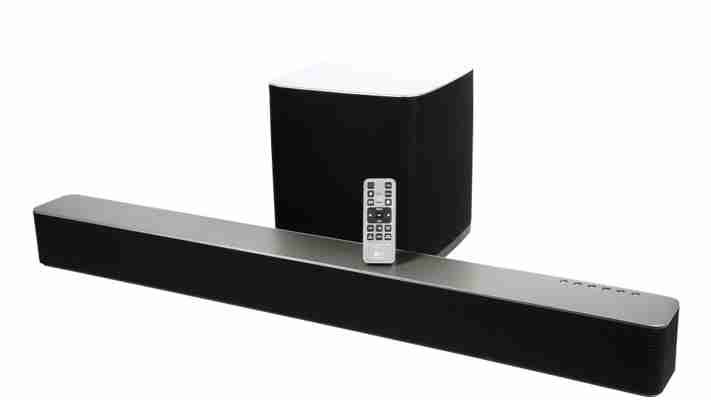The first thing I noticed about the LG MusicFlow HS9 is what an imposing figure it cuts. This is one of the biggest soundbars I’ve seen and the gargantuan size even extends to the wireless subwoofer.
LG is obviously aware that the size might prove a hindrance as it even includes an IR blaster in the box: as the HS9’s soundbar measures a substantial 1,100x140x110mm, its height will likely obstruct the infrared receiver on your television, as was the case when paired with my reference 42in television.
Adhesive feet are also included to raise the height even further in case you need to make the soundbar stand over your television’s stand. The HS9's massive length also means that it’s better suited when used with a larger television, too, unless you don’t mind the visual imbalance.
The design is a little uninspired for our tastes, with a black grille that extends the full length of the front and sides. A status display is integrated behind to let you know what setting the soundbar is set, although it’s placed off-centre, which is slightly annoying.
A full array of physical controls is on the top of the soundbar, which is useful for the times you can’t locate the included remote control or they run out of batteries. The remote control itself is compact but has plenty of controls for activating different sound modes as well as media playback controls for when you’re streaming music. The volume buttons are slightly fiddly, however.
The HS9, below, is significantly chunkier than most soundbars
The wireless subwoofer is rather squat at 296x332x296mm and could potentially be tricky to hide out of the way. It matches the design of the main soundbar, at least, with a black speaker cloth that extends around the edges and contrasting brushed silver along the top.
The brushed silver design is consistent with LG’s other MusicFlow multi-room speakers, which the HS9 can be integrated into much like Sonos’ Playbar integrates into its multiroom system. As with the Sonos Playbar, you can pair the HS9 with two separate MusicFlow speakers to create true rear satellite speakers. You’ll need to use two identical MusicFlow speakers, however. You can of course use the HS9 independently if you wish.
As a multiroom capable speaker, the HS9 is able to connect to your home network so that it can communicate with internet streaming services, networked storage and other MusicFlow speakers on your network, either through the wired Ethernet port on its rear or over Wi-Fi. Setting it up is straightforward and can be done with the MusicFlow app on iOS and Android.
You’re then able to use the HS9 just like any other LG MusicFlow speaker, such as the HS3 or HS7. You can play music from services such as Spotify, Deezer, Napster and TuneIn radio. The HS9 is also Google Cast compatible , so you can stream from compatible such as Google Play Music. Consistent with the other MusicFlow speakers, the HS9 can also handle playback of high-resolution audio files at 24-bit/192kHz.

The HS9 can be connected to your television either through HDMI, using your TV's Audio Return Channel (ARC) port, or using one of the two available digital optical connections. There’s also a 3.5mm auxiliary jack. A USB port is included for servicing only. As well as the dedicated HDMI ARC connection, there are three HDMI inputs, so you can plug in all of your other devices through the soundbar. Finally, you’ll find the Ethernet port and a connection for the IR Blaster. You can also pair an audio device to the soundbar over Bluetooth and if you have an LG Sound Sync compatible television you can connect it wirelessly, too.
All of the connections are split across two recesses and face sideways, meaning you shouldn’t have any problems plugging anything in, even if you choose to wall-mount the soundbar. The soundbar weighs a hefty 8.2kg so make sure you mount it carefully using the right type of anchors for your wall.

